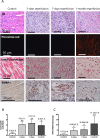Characterization and implications of the dynamics of eosinophils in blood and in the infarcted myocardium after coronary reperfusion
- PMID: 30365558
- PMCID: PMC6203260
- DOI: 10.1371/journal.pone.0206344
Characterization and implications of the dynamics of eosinophils in blood and in the infarcted myocardium after coronary reperfusion
Abstract
Objective: We characterized the dynamics of eosinophils in blood and in the infarcted myocardium in patients and in a swine model of reperfused myocardial infarction (MI). The association of eosinophil dynamics with various outcomes was assessed.
Methods: Serial eosinophil count and pre-discharge cardiac magnetic resonance were carried out in a prospective series of 620 patients with a first ST-elevation MI. In a swine model of reperfused MI, the dynamics of circulating eosinophils and their presence in the infarcted myocardium were determined. In autopsies from chronic MI patients, eosinophils were quantified.
Results: Patient eosinophil count sharply decreased 12h post-reperfusion compared to arrival. A lower minimum eosinophil count was associated with more extensive edema, microvascular obstruction, and infarct size as measured by cardiac magnetic resonance, and also with a higher rate of cardiac events (death, re-infarction, or heart failure) during follow-up. In the experimental model, eosinophil count boosted during ischemia and dropped back immediately post-reperfusion. Myocardial samples revealed progressive eosinophil migration into the infarcted myocardium, especially areas with microvascular obstruction. Markers of eosinophil maturation and survival (interleukin-5), degranulation (eosinophil cationic protein) and migration (eotoxin-1) were detected in the blood of patients, and in porcine myocardium. Eosinophil infiltration was detected in autopsies from chronic MI patients.
Conclusion: Eosinopenia post-MI was associated with an impaired cardiac structure and adverse events. The decay in circulating eosinophils soon after reperfusion mirrors their migration into the infarcted myocardium, as reflected by their presence in heart samples from swine and patients. Further studies are needed to understanding this unexplored pathway and its therapeutic implications.
Conflict of interest statement
The authors have declared no competing interests exist.
Figures






Similar articles
-
Eosinopenia in patients with acute myocardial infarction- longitudinal imaging insights from the CAPRI study.J Thromb Thrombolysis. 2025 Jan;58(1):136-144. doi: 10.1007/s11239-024-03042-6. Epub 2024 Sep 21. J Thromb Thrombolysis. 2025. PMID: 39306654 Clinical Trial.
-
Impact of myocardial haemorrhage on left ventricular function and remodelling in patients with reperfused acute myocardial infarction.Eur Heart J. 2009 Jun;30(12):1440-9. doi: 10.1093/eurheartj/ehp093. Epub 2009 Apr 3. Eur Heart J. 2009. PMID: 19346229
-
Osteoprotegerin in ST-elevation myocardial infarction: prognostic impact and association with markers of myocardial damage by magnetic resonance imaging.Int J Cardiol. 2013 Sep 1;167(5):2134-9. doi: 10.1016/j.ijcard.2012.05.101. Epub 2012 Jun 15. Int J Cardiol. 2013. PMID: 22704876 Clinical Trial.
-
The reduction of infarct size--forty years of research.Rev Port Cardiol. 2010 Jun;29(6):1037-53. Rev Port Cardiol. 2010. PMID: 20964114 Review. English, Portuguese.
-
Cardiac MRI Endpoints in Myocardial Infarction Experimental and Clinical Trials: JACC Scientific Expert Panel.J Am Coll Cardiol. 2019 Jul 16;74(2):238-256. doi: 10.1016/j.jacc.2019.05.024. J Am Coll Cardiol. 2019. PMID: 31296297 Free PMC article. Review.
Cited by
-
Microvascular Obstruction in ST-Segment Elevation Myocardial Infarction: Looking Back to Move Forward. Focus on CMR.J Clin Med. 2019 Oct 28;8(11):1805. doi: 10.3390/jcm8111805. J Clin Med. 2019. PMID: 31661823 Free PMC article. Review.
-
Leukocyte-Mediated Cardiac Repair after Myocardial Infarction in Non-Regenerative vs. Regenerative Systems.J Cardiovasc Dev Dis. 2022 Feb 21;9(2):63. doi: 10.3390/jcdd9020063. J Cardiovasc Dev Dis. 2022. PMID: 35200716 Free PMC article. Review.
-
A scalable, clinically severe pig model for Duchenne muscular dystrophy.Dis Model Mech. 2021 Dec 1;14(12):dmm049285. doi: 10.1242/dmm.049285. Epub 2021 Dec 16. Dis Model Mech. 2021. PMID: 34796900 Free PMC article.
-
Eosinophil percentage as a new prognostic marker in patients with ST-segment elevation myocardial infarction undergoing primary percutaneous coronary intervention.Interv Med Appl Sci. 2019 Oct 7;11(3):146-153. doi: 10.1556/1646.11.2019.17. eCollection 2020 Sep. Interv Med Appl Sci. 2019. PMID: 36343299 Free PMC article.
-
The predictive value of eosinophil levels on no-reflow in patients with STEMI following PCI: a retrospective cohort study.Sci Rep. 2022 Oct 25;12(1):17862. doi: 10.1038/s41598-022-22988-2. Sci Rep. 2022. PMID: 36284176 Free PMC article.
References
Publication types
MeSH terms
Substances
LinkOut - more resources
Full Text Sources
Medical

